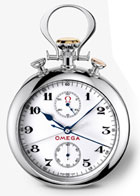It was luck, pure
luck. In one of the most extraordinary discoveries ever made
at Omega, workers clearing out a warehouse not far from
company headquarters in Bienne, Switzerland, came across a
pile of boxes that had not been touched for decades. No one at
Omega knew of their existence, much less what treasures lay
within.
Unbelievable. They
were original components – all the parts necessary to build
a pocket watch chronograph rattrapante movement. And not just
any movement! The recovered components were those used to
build the very movement at the heart of the famous 30
stopwatches Omega delivered to Los Angeles for the Olympic
Games of 1932.
The discovery of the
movement assembly kits caused great excitement at Omega
headquarters, where in-house experts soon determined that many
of the 180 parts and sub-assemblies in each kit were in
surprisingly good condition. From that point on there was no
looking back, and within a few months Omega had produced an
exquisite replica of the 1932 pocket watch that made history
in Los Angeles.
The art of a
movement
Based on the 1932 design and built from restored and enhanced
components and a small number of new parts, the Omega calibre
3889A is a high-performance mechanical movement with an
integrated rattrapante chronograph mechanism controlled by a
double column wheel. The 24’’’ (53.7mm) movement beats
at 36,000 alternations per hour, enabling accuracy to 1/10th
of a second. Prior to assembly, the gilt plates and bridges of
the 1932 design were restored, rhodium-plated and enhanced
with circular graining and Geneva waves. All steel components
are satin-brushed, and the two column wheels are blued steel.
The chromium-plated
metal cases of the 1932 model were replaced by hand-crafted
18-carat yellow, white or red gold watchcases, and the
contemporary edition, like the original, features an exquisite
57mm white enamel dial with a recessed 30-minute totalizer at
12 o’clock and a recessed continuous seconds dial at 6
o’clock, both with black enamel “railroad track” rings.
The black enamel Arabic numerals and 5-60 minute-scale,
graduated to 1/5th second, and the red enamel Omega name and
symbol are identical to those of the Omega chronographs used
at the Olympic Games in 1932.
A timekeeper’s
dream
The enormous care taken by Omega’s master watchmakers in
restoring and assembling the recovered movement kits enabled
the Pocket Watch 1932 to achieve official COSC certification
as a chronometer. Like the original, it is accurate to 1/10th
of a second. The chronograph start, stop and re-set functions
are integrated in the crown; beneath the crown is a
safety-lock wheel to prevent involuntary stoppage of the
chronograph - an essential feature for the official
timekeepers at the Los Angeles 1932 Olympic Games! The
pushbutton at 11 o’clock controls the rattrapante function,
which allows timekeepers to record intermediate (lap) times
during a race; the hours, minutes and seconds are set by
holding down the 1 o’clock pushbutton and winding the crown.
Pieces of 8
In Chinese culture, the number 8 is considered lucky – a
sign of prosperity and wealth. So it’s not by chance that
the Beijing 2008 Olympic Games are set to begin on the 8th day
of the 8th month in the year 2008 – at 8.00 o’clock in the
evening! And when Omega presented an Omega Pocket Watch 1932
to Kong Fanzhi, Director of the Beijing Cultural Relics
Protection Bureau, nothing was left
to chance: the edition number engraved on the case was – 88.
